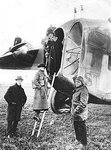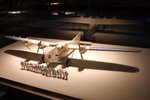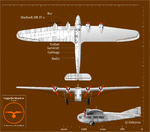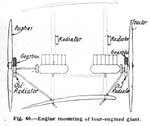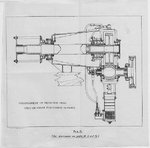delcyros
Tech Sergeant
While writing down a booklet for a friend, I was wondering about the Zeppelin Staaken R-VI successor.
The original Zeppelin Staaken R-VI is well known for it´s unparalleled size, beeing the first bomber with enclosed cockpits and supercharged engines.
What perhaps is less well known is that Zeppelin-Staaken was working on a number of modifications to the plane (R-XII to R- XVI) until it started a general new conception in 1918, whiches resulting Zeppelin-Staaken R-XVII was nothing short than a quantum leap in bomber design in general appearance. The end of world war one closed the files but Zeppelin Staaken was eager to modify the R-XVII into a purely civil version. Small parts construction on the so called "1000 hp" plane started in may 1919 at Berlin-Staaken.
Designed by Baumann and Rohrbach, who favored thick-wing cantilever monoplanes, but unlike Junkers, who used tubes and ribs covered with corrugated sheet, Rohrbach used dural stressed skin employing a single torsion-box spar running from wingtip to wingtip, its smooth top and bottom serving as the wing's upper and lower surfaces. Leading- and trailing-edge ribs, attached to the front and back faces of this box and covered with thin dural sheet, gave the wing its shape. His E.4/20 of 1920 was a streamlined, all-dural design powered by four engines, weighing 18,700 pounds loaded. Only large wheels and landing gear struts marred its lines, and its high-placed, tapered, cantilever wing spanned 102 feet. It had a cabin that seated up to 18, as well as a lavatory and generous mail and luggage space.
The fuselage was completed in june, 1920 and the allied controll commission allowed testflights under supervision of french and british officers with Maybach IVa-engines. The maiden flight was on sept. 30th with Carl Kuring.
At its first flight, in 1920, both its design and performance—cruising more than 130 mph at less than full power, and ranging nearly 850 miles—were a good dozen years beyond what any other airliner had attained.
The allied controll commission regarded the legend performance as to high to be considered as a civil plane (top speed in excess of allied fighter top speeds) and Zeppelin had to deliver the engines back to ILÜK while it could keep but was forbidden to sell the fuselage and wings.
But though never itself produced, many of its features—stressed skin, torsion-box spar, leading edge engines, and gracefully tapered wing—became standard elements of long-range aircraft, as did its general configuration.
The USA sent two engeneerers to Zeppelin in order to negotiate with and perhaps buy licenses from Zeppelin Staaken but Reinhart and Deeds arrived only to be informed that the plane had to be scrapped by orders of the allied controll commission.
The ILÜK decision to scrap the prototype has to be seen in relation with early allied high altitude trials, such as the french Villacoublay trials of 1918 where the max. speed of a turbocharged fighter was 205 Km/h @ 4.500m (very comparable to the 205 Km/h at this altitude of the actual performance projection for the E4/20).
Further reading:
A. K. Rohrbach, "Das 1000-PS Verkehrsflugzeug der Zeppelin-Werke, Staaken," Zeitschrift für Flugtechnik und Motorluftschiffahrt, vol. 12, no. 1 (15 Jan. 1921);
E. Offermann, W. G. Noack, and A. R. Weyl, Riesenflugzeuge, in: Handbuch der Flugzeugkunde (Richard Carl Schmidt Co., 1927).
Peter W. Brooks, article in Air Pictorial (June 1986). [thanks, Graeme!]
The original Zeppelin Staaken R-VI is well known for it´s unparalleled size, beeing the first bomber with enclosed cockpits and supercharged engines.
What perhaps is less well known is that Zeppelin-Staaken was working on a number of modifications to the plane (R-XII to R- XVI) until it started a general new conception in 1918, whiches resulting Zeppelin-Staaken R-XVII was nothing short than a quantum leap in bomber design in general appearance. The end of world war one closed the files but Zeppelin Staaken was eager to modify the R-XVII into a purely civil version. Small parts construction on the so called "1000 hp" plane started in may 1919 at Berlin-Staaken.
Designed by Baumann and Rohrbach, who favored thick-wing cantilever monoplanes, but unlike Junkers, who used tubes and ribs covered with corrugated sheet, Rohrbach used dural stressed skin employing a single torsion-box spar running from wingtip to wingtip, its smooth top and bottom serving as the wing's upper and lower surfaces. Leading- and trailing-edge ribs, attached to the front and back faces of this box and covered with thin dural sheet, gave the wing its shape. His E.4/20 of 1920 was a streamlined, all-dural design powered by four engines, weighing 18,700 pounds loaded. Only large wheels and landing gear struts marred its lines, and its high-placed, tapered, cantilever wing spanned 102 feet. It had a cabin that seated up to 18, as well as a lavatory and generous mail and luggage space.
The fuselage was completed in june, 1920 and the allied controll commission allowed testflights under supervision of french and british officers with Maybach IVa-engines. The maiden flight was on sept. 30th with Carl Kuring.
At its first flight, in 1920, both its design and performance—cruising more than 130 mph at less than full power, and ranging nearly 850 miles—were a good dozen years beyond what any other airliner had attained.
The allied controll commission regarded the legend performance as to high to be considered as a civil plane (top speed in excess of allied fighter top speeds) and Zeppelin had to deliver the engines back to ILÜK while it could keep but was forbidden to sell the fuselage and wings.
But though never itself produced, many of its features—stressed skin, torsion-box spar, leading edge engines, and gracefully tapered wing—became standard elements of long-range aircraft, as did its general configuration.
The USA sent two engeneerers to Zeppelin in order to negotiate with and perhaps buy licenses from Zeppelin Staaken but Reinhart and Deeds arrived only to be informed that the plane had to be scrapped by orders of the allied controll commission.
The ILÜK decision to scrap the prototype has to be seen in relation with early allied high altitude trials, such as the french Villacoublay trials of 1918 where the max. speed of a turbocharged fighter was 205 Km/h @ 4.500m (very comparable to the 205 Km/h at this altitude of the actual performance projection for the E4/20).
Further reading:
A. K. Rohrbach, "Das 1000-PS Verkehrsflugzeug der Zeppelin-Werke, Staaken," Zeitschrift für Flugtechnik und Motorluftschiffahrt, vol. 12, no. 1 (15 Jan. 1921);
E. Offermann, W. G. Noack, and A. R. Weyl, Riesenflugzeuge, in: Handbuch der Flugzeugkunde (Richard Carl Schmidt Co., 1927).
Peter W. Brooks, article in Air Pictorial (June 1986). [thanks, Graeme!]


